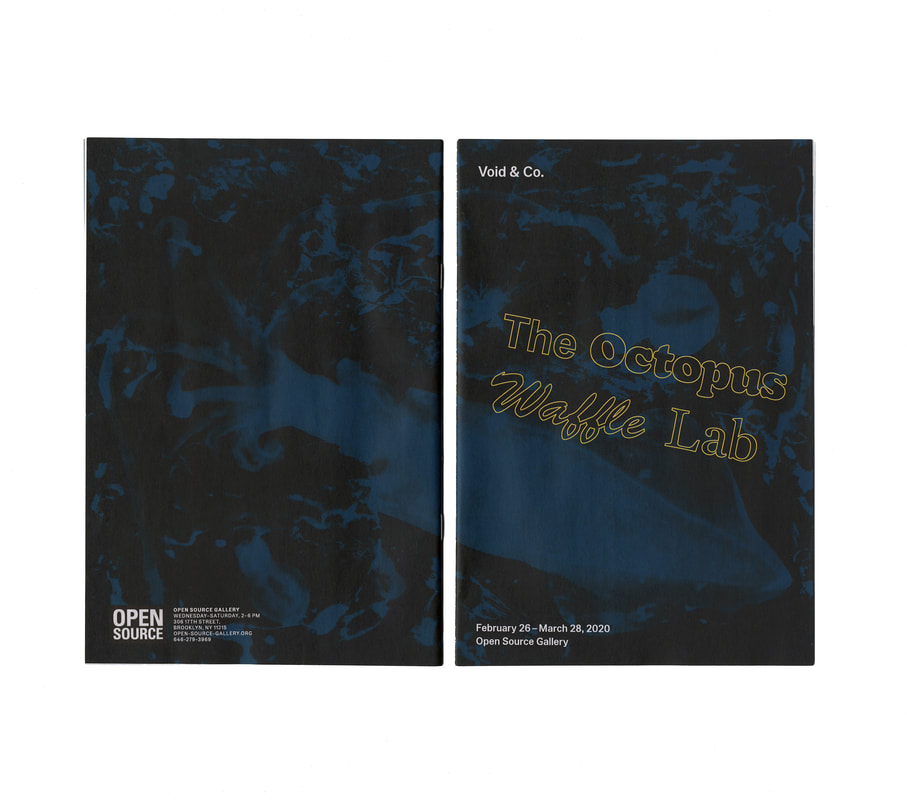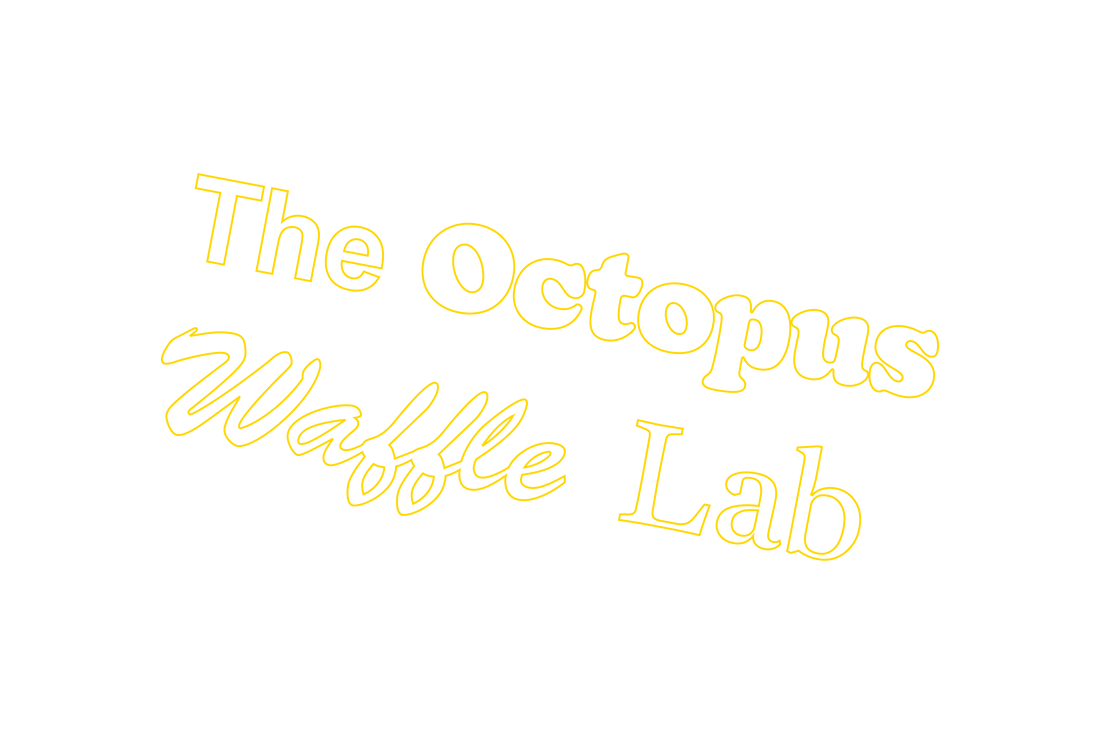|
Booklet
Void & Co. The Octopus Waffle Lab February 26 – March 28, 2020 Open Source Gallery Open Source Gallery and Void & Co. are pleased to precent the booklet produced to accompany The Octopus Waffle Lab with an essay by Louis Block and graphic design by Mike Tully.
Earlier this year the participatory exhibition, The Octopus Waffle Lab, by the Danish duo Void & Co, took place at Open Source Gallery. The project explored food culture and heritage, superstitions and emotional connections to food in a time where what we eat shapes the future. © Void & Co. 2020 Published by Open Source Gallery, Writing, Editing: Louis Block Photography: Stefan Hagen, Anja Matthes and Void & Co. Design: Mike Tully Typefaces: True sans, Doyle Printing: Newspaper Club Edition of 200 20 Pages Copies of the booklet are available for purchase by sending an email to: USA: [email protected] Internationally: [email protected] A huge thank you to Open Source Gallery! Especially Mike Tully, Louis Block, Morten Luxhøi, Stina Mølgaard, Anja Matthes, Stefan Hagen, Sabine Rosenstein, Gerda Lindsted, Elise Barløse Andersen, Christine Katscher and Pirmin Hagen. Simon, Oskar & Carlo. SíM Residency. The supporters of the program and project: Open Source Gallery’s Patrons, Danish Art Workshops and Land Vorarlberg. This program is partly funded by the Joseph Robert Foundation, the Albers Foundation and the New York City Department of Cultural Affairs, in partnership with the City Council. Open Source Gallery programming is made possible by the New York State Council on the Arts with the support of Governor Andrew M. Cuomo and the New York State Legislature. |
Dining at the Octopus Waffle Lab
by Louis Block In Danish, the various species of cephalopods—octopuses, squids, cuttlefish, and other tentacled beings—are classified with a single noun: blæksprutte, literally, ink sputterer. We can imagine, for early swimmers and fishermen, that taxonomic distinction might seem a futile task when faced with these multi-armed underwater painters. Their ink, thick with melanin, streams into dark blue and brown clouds, turning day to night. And, as if a disorienting smokescreen were not enough, some species have the ability to release concentrated bursts of mucus-thick ink in tentacled clusters known as pseudomorphs, doppelgängers that fool other sea creatures. That these species are grouped according to a common action rather than physical attributes or genetic evidence speaks to their enduring mythological status. Sea monsters, the erotic tentacles of a Hokusai print—these are not representations of specific animals per se, but underwater enigmas upon which we can imprint our fears and desires. Watching Ditte Knus Tønnesen and Ronja Svaneborg pour ink-stained batter into waffle irons, it is hard not to see the spreading rivulets as grasping tentacles, the puffed grids of the steaming waffles as composed of anxious suckers, slowly anticipating a diner’s kiss. Tønnesen and Svaneborg, operating as the collective Void & Co., have transformed Brooklyn’s Open Source Gallery into an octopus themed waffle bar cum food lab, complete with an underwater soundscape and dramatic photograms of mollusk bodies. The artists-as-performers, clad in matching blue food service outfits, take orders from a food cart, a palette of ingredients before them: seaweed, turmeric, coffee, chamomile, crickets, lavender, vinegar, mushrooms, honey, flaxseed, dried cod, rose petals—all staining and perfuming the gridded treats. Beyond offering culinary curiosities, the Lab asks an important question: can food be more than consumption and glamour, more than sustenance, social responsibility, or decadent celebration? What if food offered more than its nutritional value and cultural capital, and entered into a looser field, where interspecies knowledge and speculative reasoning come into play? This space, carved out by a seemingly absurd concoctive gesture, might shorten the gap between the consumer and the consumed. In other words, the abstract and opaque systems of food distribution in our contemporary condition may be countered by equally abstract movements on the other side; movements espousing dissonance, disgust, symbolism, even sexuality. To understand how Void & Co.’s waffles operate through this lens, it seems appropriate to speak of two emotional poles present in the viewer’s mind: fear and sensuality. First, the smell. Its overwhelming sweetness. There is something about the warm, flat note of wheat in concert with seafood’s lingering mustiness that forms an olfactory paradox. While the waffle’s primary scent is a nostalgic call back to the hearth, its oceanic component—octopus, dried and ground to a powder—presents a direct antagonism. Is the scent of seafood not some funereal message issuing from an upside-down world from which life is plucked and washes up? This waffle treads water; on one side lives memory, comfort, habit, and on the other, murkier territory, alien knowledge. We can dissect it even further: the wheat’s gluten stretches itself into one sticky mass, reanimating a whole that was ground apart long ago at some mill, while the squid’s desiccated particles stagnate and putrefy, caught in the bubbling mess. On one side, a nutritious glue facilitating new life, on the other, an animal’s life, dispersed, measured in grams of protein. Many myths would have us believe that tentacles exist to breach into our human world. The Norse kraken or Jules Verne’s giant squids are creatures that terrorize their victims while remaining hidden under the ocean, their multiplying arms corralling sailors into the depths. Maybe it is something about this predatory mythology that prompts hesitation before biting into a squid-infused treat. In the gallery, a looping soundscape furthers the underwater mystery with bubbles, whale calls, and ambiguous marine audio. We might also think of Homer’s sirens, with their deceptive songs, as analogs to tentacle monsters that grasp and consume seafarers, traversing barriers to reach into the human psyche. But all of this disregards the lived experience of these organisms, fluttering and sputtering in abundant numbers in our oceans. Octopuses can taste with their suckers, and pass their prey from sucker to sucker down to their beaks. Imagine the ecstasy of enveloping yourself in your meal, of hugging and kissing and tasting with the same appendages. No wonder Hokusai and other ukiyo-e artists depicted octopuses as erotic partners, their sucking and kissing tentacles tangled up with human limbs. So, when all of these divergent forces hit the griddle, their singular aroma signals a sort of alchemy at play. Powder and liquid create form, plant and flesh lending nourishment. But more is at stake: in this hyper-focused environment, where every detail points toward the transformative power of cephalopods, the act of eating promises the absorption of some of these creatures’ characteristics, a type of becoming what you eat. As in Julio Cortázar’s “Axolotl,” where the narrator slowly embodies the amphibian that he obsesses over, eventually staring back into his own eyes as a captive animal, flesh seems able to jump through divides—vitrines or the ocean surface—to share knowledge. It is in fact not unprecedented to try to gather the essence of squids for human use. Perfume makers have long prized ambergris, a rare substance that sometimes washes up on the coast. The striated, rock-like material is formed in the intestines of sperm whales, where undigested squid beaks gather and harden with bile over years. Once released, the ambergris floats out at sea, oxidizing and maturing in the sunlight. In 1895, a Times reporter described the scent as “like the blending of new-mown hay, the damp woodsy fragrance of a fern-copse, and the faintest possible perfume of the violet.” Under the right conditions, even particles of death and decay can be transmuted and commodified. Studying Void & Co.’s photograms of mollusk bodies as well as their pre-packaged waffle mix, a picture of the artists as provisional scientists emerges: ink seeping into photographic chemicals, precise beams of light shining through translucent bodies, measuring cups and scales stained with slippery marks. Though the installation borrows from the capitalist language of commodity and choice, this food’s production is individualized, not industrialized. Blæksprutte, the ink sputterer, must be defined by its ability to paint false pictures, to write rippling copies of itself underwater, and by its psychedelic camouflaging in hostile environments. This type of essential visual play is represented in the Lab by an array of toppings and ingredients for the visitor to add to their own waffle. Sprinkles, dyes, and powders ensure that each plate holds a unique image, a kind of momentary self portrait. Once their waffles are half-eaten, visitors are prompted to place the remaining half on the gallery wall along with written archive cards, where they accumulate as a kind of chance abstraction. Schoolchildren have written down the desired effects for their various waffles: a group of eleven year olds hope that their lavender and ink infused waffle will increase their basketball skills, while some seven year olds seek to gain greater strength with octopus, rose, and pineapple. Another visitor writes: “We’re all unbalanced. Or imbalanced. Octopus might be the solution.” Slowly, these floppy tablets build a picture of reticence and hunger; at their edges, a faint language of bite marks emerges, ranging from timid nibbles to a confident chomp straight through the center of one jet-black specimen. This grid of grids wobbles on its shelf, the waffles taking on a cartoonish quality, like tall buildings swaying in an earthquake or forgotten petri trays overtaken by multicolored viruses and cures sparring in topographic view. In these indents and craters we can read a multitude of histories: the suckered scars incised on whale skin from battles with giant squid, hickeys and marks left on a lover’s neck, or styrofoam artifacts to be dug up hundreds of years from now, warped and compressed under future cities. Though some of these waffles were met with disgust, others were devoured with relish, their slight fishiness an unexpected delight. For an uncertain future, where our unsustainable habits will soon force us to consider alternate and radical food sources, we might take solace in the fact that squid ink is known to contain not only mucus and melanin, but also dopamine, a chemical partly responsible for desire in the human brain. So, watching the ink’s pigment swirl and sizzle in the waffle iron, intoxicated by its aroma, it seems possible to glimpse into an unknown underwater world, to inhabit the life you are about to eat, and in one clean motion, to be met by your own lips, surprisingly human, real. |

